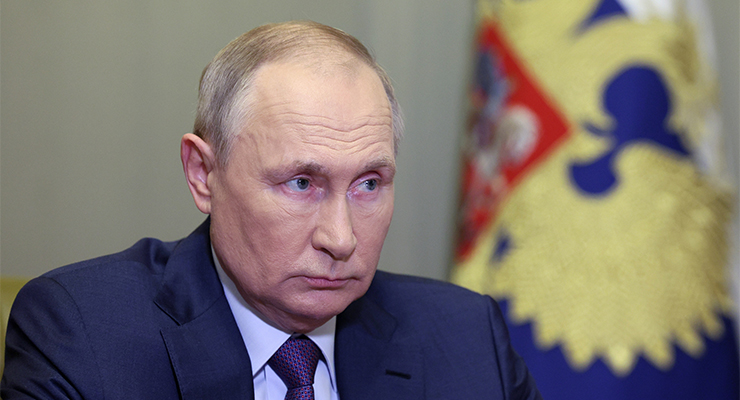
For much of the past year, and since his invasion of Ukraine last February, Russian President Vladimir Putin has been riding high on his supposed energy omnipotence, holding the global economy hostage to his whims.
Since mid-2022, Putin has choked off natural gas supplies to Europe, hoping that Europeans, shivering and without heat during the winter, would turn on their leaders and make it politically unfeasible to continue support for Ukraine.
The threat was potent: in 2021, a whopping 83% of Russian gas was exported to Europe. Russia’s total global exports of 7 million barrels of oil a day and 200 billion cubic metres (bcm) of piped gas a year accounted for about half of its federal revenue. Even more importantly, Russia’s commodities exports played a crucial role in global supply chains: Europe was reliant on Russia for 46% of its total gas supply, with comparable levels of dependence on other Russian products including metals and fertiliser.
Now, as we approach the one-year anniversary of Putin’s invasion, it is apparent that Russia has permanently forfeited its erstwhile economic might in the global marketplace.
Thanks to an unseasonably warm winter in Europe, Putin’s moment of maximum leverage has passed uneventfully and, as we correctly forecast last October, the biggest victim of Putin’s gas gambit was Russia itself. Putin’s natural gas leverage is now nonexistent, as the world — and, most importantly, Europe — no longer needs Russian gas.
Far from freezing to death, Europe quickly secured alternative gas supplies by pivoting to global liquefied natural gas (LNG). This included an estimated 55 bcm from the United States, two and a half times more than prewar US exports of LNG to Europe. Coupled with increases in supply from renewable sources, nuclear and, in the interim, coal, these alternative supplies have reduced Europe’s dependence on Russian gas to 9% of its total gas imports. In fact, Europe now purchases more LNG than it ever purchased Russian gas.
Furthermore, Europe’s unseasonably warm winter means that not only have the worst-case scenarios been avoided, but Europe’s full storage tanks have barely been drawn down and can carry over into next winter. In January, German storage tanks were a record 91% full, up from 54% last year, meaning that Europe will need to buy significantly less gas in 2023 than in 2022.
The implications are tremendous. Europe is now assured sufficient energy supply well into 2024 at a minimum, providing enough time for cheaper alternative energy supplies — both renewables and bridge fuels — to be fully onboarded and operating within Europe. This includes the completion of an additional 200 bcm/year in LNG export capacity by 2024 — enough to fully and permanently replace Russia’s 200 bcm/year gas exports once and for all.
Furthermore, the days of globally expensive energy amid “Russia-driven supply squeezes” are over for good. In addition to Europe’s lower expected demand for LNG, China is pivoting away from global LNG in favor of domestic sources. Coupled with the rapidly increasing LNG supply, it is little surprise that the gas futures market is now pricing gas to be cheaper than prewar levels for years to come.
Putin, on the other hand, has zero remaining leverage and no way to replace his erstwhile primary customer; he is finding out the hard way that it is much easier for consumers to replace unreliable commodity suppliers than it is for suppliers to find new markets. Already, Putin is drawing practically no profit from gas sales, as his prior 150 bcm sales of piped gas to Europe have been replaced by a measly 16 bcm to China and pocket change in global LNG sales, barely enough to cover expenses. There are no markets for Putin to replace anything close to that 150 bcm shortfall: China lacks the necessary pipeline capacity to take any more for at least a decade and prefers domestic and diversified sources of energy anyhow, while Russia’s laggard technology makes it impossible to scale LNG exports beyond a slow trickle.
Putin’s oil leverage is likewise diminishing. Gone are the days when fear of Putin taking Russian oil supplies off the market caused oil prices to skyrocket by 40% over two weeks. In fact, when — in response to last month’s rollout of the G7 oil price cap, which we helped develop — Putin announced a ban, from February 1, on oil exports to countries that accepted the price cap, oil prices actually went down.
Why? Because it is now apparent that the world no longer depends on Putin’s oil. The oil market is turning to favor buyers, not sellers, amid increasing supply — more than enough to compensate for possible drops in Russian crude production. (In December, Russian Deputy Prime Minister Alexander Novak told Russian media that the government was prepared to cut crude production by up to 700,000 barrels in 2023.) Oil prices are lower now than before the war, and in the second half of 2022 alone, there was a surge of supply by 4 million barrels a day from producers such as the United States, Venezuela, Canada, and Brazil. With even more new supply expected this year, any lost Russian crude will be seamlessly and easily replaced within weeks. And this time, Putin cannot coerce Saudi Arabia to ride to the rescue by drastically cutting OPEC+ production quotas as it did last October. That’s because the United States is now pausing crucial Saudi arms and technology transfers amid heightened international scrutiny of OPEC+’s significant surplus unused capacity.
Putin’s leverage has also evaporated because the G7 price cap gives him a lose-lose choice, which erodes Russia’s energy position no matter what he does. China and India, without explicitly participating in the cap, are leveraging it to drive a hard bargain with Russia, with discounts of up to 50%, so even though India is buying 33 times more Russian oil than it was a year ago, Russia is not making much profit, given its $44 break-even cost of production on top of costlier transportation. But if Putin cuts production even more, as he has threatened to do, he will be forfeiting all-important oil market share, long a Putin obsession, amid an increasingly oversupplied oil market and further cutting into his own revenue when he is already starved for cash.
Even Putin’s other commodities cards are all used up. His gambit to weaponise food abjectly collapsed when even his nominal allies turned on him. And in certain metals markets where Russia historically dominated, such as nickel, palladium, and titanium, blackmail-fearing buyers combined with higher prices have expedited reshoring and reinvigorated dormant public and private investment in critical mineral supply chain and mining projects. These are mostly in North and South America and Africa, home to many undertapped mineral reserves. In fact, in several crucial metals markets, such as cobalt and nickel, the combined output of new mines to be opened in the next two years adds up to more than enough supply to replace Russian metals within global supply chains permanently.
Putin’s failed economic gambits are yet another set of miscalculations to add to an increasingly long list, from his underestimation of the people of Ukraine to his underestimation of the collective unity and willpower of the West.
Of course, Putin’s failed economic and energy warfare has not been without consequence. The spillovers have impacted many lives, transformed supply chains, changed trade flows, and consumers still feel the pinch of higher prices as the newfound lower prices take some time to work through the economy.
But what matters is that the end is in sight. Never again will Putin be in a position to cause such chaos and disturbance in the global economy, because he has permanently weakened Russia’s most powerful hand — its energy and commodities might — beyond repair. The war on the battlefield is still being fought, but on the economic front at least, victory is in sight.










As the British used to say when an IRA bomb maker blew himself up ” I suppose Putin has scored an own goal, then”.
It is a pity about the collateral damage, but, that also means he has less friends than he did.
“All hail, Vlad the Weaner!”
“BCM” is the oil industry’s jargon, which we should not indulge. Converted to the SI units that we all learned in school, 55 billion cubic metres of gas amounts to 2090 petajoules. If that was spread over all of one year’s imports, that would be 66.2 GW, so the traffic is likely to be more than 100 GW. Once you say it like that, the quantity is clearly enormous.
Then why are our domestic energy prices still so high?
Mainly because the companies that extract gas from Australia play us for fools. Prices are quick to rise and slow to fall. Avoid tax and leave problems, but this is another discussion by itself.
Crikey obviously believes Putin started this war because he is a demented Despot who wants to reconstitute the Soviet Empire. No mention of Maidan, the two broken Minsk Agreements, the 8-year war by the Ukrainian Nazis on Donbas, the reality many in the USA – Mearsheimer just one example – acknowledge this is yet another US Proxy War, yet Crickey keeps publishing this propaganda…
Is that you, Tucker?